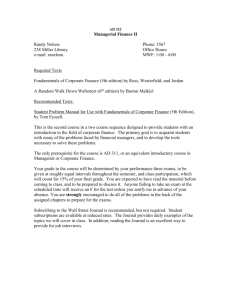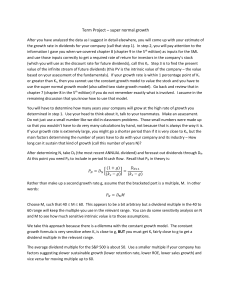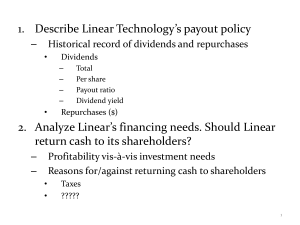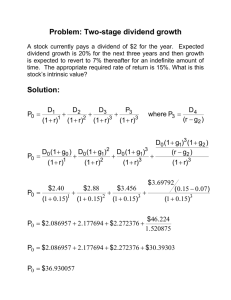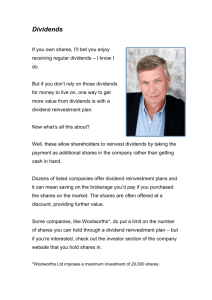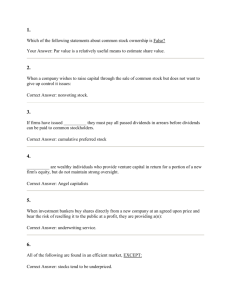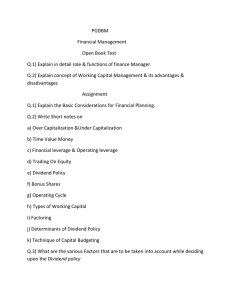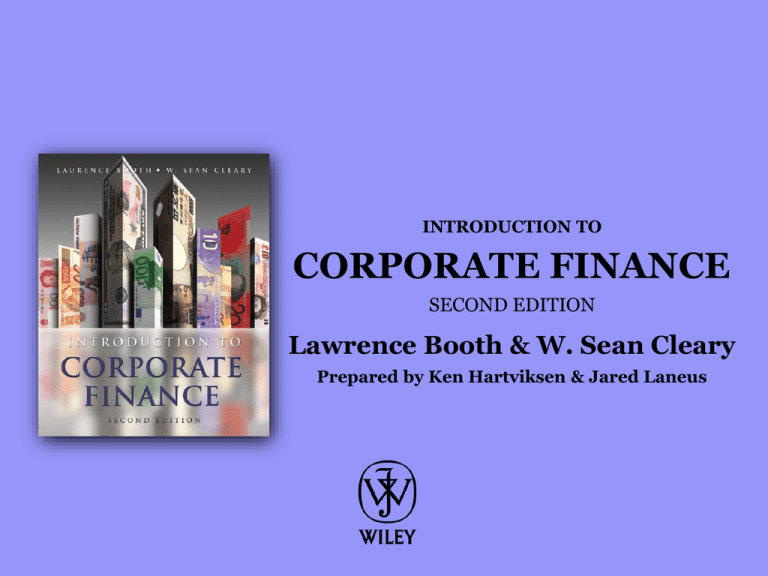
INTRODUCTION TO
CORPORATE FINANCE
SECOND EDITION
Lawrence Booth & W. Sean Cleary
Prepared by Ken Hartviksen & Jared Laneus
Chapter 22
Dividend Policy
22.1 Dividend Payments
22.2 Cash Dividend Payments
22.3 Modigliani and Miller’s Dividend Irrelevance
Theorem
22.4 The “Bird in the Hand” Argument
22.5 Dividend Policy in Practice
22.6 Relaxing the M&M Assumptions: Welcome to the
Real World!
22.7 Share Repurchases
Booth/Cleary Introduction to Corporate Finance, Second Edition
2
Learning Objectives
22.1 Explain what a cash dividend payment is, how dividend payments are
made, and why dividend payments are different from interest payments.
22.2 Describe typical dividend payouts and explain the importance of
dividends.
22.3 Explain how Modigliani and Miller (M&M) proved that dividend
payments are irrelevant, due to the existence of homemade dividends,
and therefore have no impact on market value.
22.4 Explain why dividend payments generally reflect the business risk of the
firm and explain what the “bird in the hand” argument is.
22.5 Explain why firms are reluctant to cut their dividends and why they
smooth their dividends.
22.6 Explain why dividends are not a residual, as implied by M&M.
22.7 Describe what a share repurchase program is and explain how it can
substitute for dividend payments.
Booth/Cleary Introduction to Corporate Finance, Second Edition
3
Dividend Payments
• Dividend policy is the explicit or implicit decision of the Board of
Directors on the amount of residual earnings that should be
distributed to shareholders
• Dividend policy is considered to be a financing decision because the
profits of the corporation are an important source of financing
available to the firm
• Dividends are a permanent distribution of residual earnings of the
corporation to its owners and can be in the form of: cash, shares of
stock, or property
• If a firm is dissolved, a final dividend of any residual amount made to
shareholders at the end of the process is called a liquidating
dividend
Booth/Cleary Introduction to Corporate Finance, Second Edition
4
Dividend Policy as a Financing Decision
• Corporate after-tax earnings accrue to the benefit of shareholders
and can either be retained for reinvestment in the firm, or paid to
shareholders
• When a cash dividend is declared, those funds leave the firm
permanently and irreversibly
• The proportion of earnings to be paid as a dividend is an important
financing decision because the payment of dividends may starve the
company of funds required for growth and expansion causing the
firm to seek additional external capital
• Firms sometimes issue special dividends which are paid in addition
to the regular dividend
Booth/Cleary Introduction to Corporate Finance, Second Edition
5
Dividends versus Interest Payments
• Interest is a payment to lenders for the use of their funds for a
specified period of time
• Secured lenders (bondholders) have the first claim on the firm’s
assets in the case of dissolution or in the case of bankruptcy
• Firms are legally obligated to make interest payments on
schedule, and the failure to pay interest and fulfill other
contractual commitments under the bond indenture or loan
contract is an act of bankruptcy for which the lender can take the
borrower to court
Booth/Cleary Introduction to Corporate Finance, Second Edition
6
Dividends versus Interest Payments
• Dividends are discretionary payments, made to shareholders, who
are residual claimants of the firm
• There is no legal obligation for firms to pay dividends to common
shareholders.
• Furthermore, by law, board members cannot pay dividends out of
capital, when it could cause insolvency, or if it causes a breach of
debt covenants
• Unlike interest, the decision to distribute dividends is taken solely
at the discretion of the board of directors
Booth/Cleary Introduction to Corporate Finance, Second Edition
7
The Mechanics of Cash Dividend Payments
Example:
May 1 – Dividend declared
May 13 – Ex-dividend date
May 15 – Record date
May 31 – Dividend payment date
• On the declaration date (May 1), the board of directors decides it will pay a
dividend on May 31.
• The dividend announcement will specify that holders of record on the date
of record (May 15) will be entitled to receive the declared dividend on the
payment date (May 31)
• On most exchanges common share transactions are settled three business
days after the trade, so the ex-dividend date (the date after which the
shares trade without the right to receive the declared dividend) will be two
days prior to the record date (e.g., May 13, if May 15 is the record date)
• A shareholder who sells on May 14 will therefore receive the dividend
Booth/Cleary Introduction to Corporate Finance, Second Edition
8
Dividend Payments
Booth/Cleary Introduction to Corporate Finance, Second Edition
9
Dividend Reinvestment Plans (DRIPs)
Dividend Reinvestment Plans (DRIPs)
• DRIPs allow shareholders to use the cash dividend proceeds to buy
more shares of the firm, effectively reinvesting their dividends in the
firm
• This allows shareholders to buy as many shares as the cash dividend
allows and the residual amount will be deposited as cash
• Firms are therefore able to raise additional common stock capital each
time a dividend is paid at no cost
Booth/Cleary Introduction to Corporate Finance, Second Edition
10
Stock Dividends
Stock Dividends
• Stock dividends result when firms distribute additional shares to
existing shareholders instead of cash
• Stock dividends represent nothing more than the recapitalization of the
company’s earnings, since the amount of the stock dividend is
transferred from the retained earnings account to the common share
account
• Because of the capital impairment rule, stock dividends reduce the
firm’s ability to pay dividends in the future
Booth/Cleary Introduction to Corporate Finance, Second Edition
11
Stock Dividend Example
Example: ABC declares a 10% stock dividend,
has 215,000 shares outstanding, and its
shares are currently $40 each.
• Since there are 215,000 shares
outstanding, a 10% stock dividend requires
21,500 new shares be issued. At $40 each,
this has a value of $860,000 which will be
transferred from the retained earnings
account to the common stock account.
Common stock
$5,000,000
Retained earnings
$20,000,000
Net worth
$25,000,000
Common stock
$5,860,000
Retained earnings
$19,140,000
Net worth
$25,000,000
• New share price = Old price / 1.1 = $40 / 1.1 = $36.36
• But, a new shareholder will have 10% more shares so her wealth will
remain unchanged.
Booth/Cleary Introduction to Corporate Finance, Second Edition
12
Stock Splits
• Although there is no theoretical explanation, some believe that an
optimal price range exists for a company’s common shares because
there is greater demand for shares that are traded in the $40 to $80
range
• Stock splits decrease the per unit share price to keep a share trading in
the preferred price range, which has psychological appeal
• The result of a stock split is both an increase in the number of shares
outstanding but no net change in shareholder wealth
• There is some evidence that the share price of companies that use
stock splits to keep the price their shares in a preferred range is more
buoyant because of a positive signal being transferred to the market by
the act of initiating the stock split
• Reverse splits allow a company whose shares have fallen in price below
the preferred range to restore its shares to the preferred range
Booth/Cleary Introduction to Corporate Finance, Second Edition
13
Stock Split Example
Common stock
Example: XYZ has 100,000 shares
outstanding which are trading for $150 each.
$1,500,000
Retained earnings
$15,000,000
Net worth
$16,500,000
• A 2 for 1 stock split will double the number of shares outstanding to
200,000 and halve the share price to $75
• A 4 for 3 stock split will increase the number of shares outstanding to
133,333 and drop the share price to ¾ of $150, or $112.50
• A 3 for 4 reverse stock split will decrease the number of shares
outstanding to 75,000 and increase the share price to 4/3 of $150 or $200
• The equity accounts will not be changed by any of the above split or
reverse split examples
• A firm can therefore use splits and reverse splits to place the firm’s stock
in a particular trading range
Booth/Cleary Introduction to Corporate Finance, Second Edition
14
Cash Dividend Payments
• Figure 22-2 shows that:
• Aggregate after-tax profits run at approximately 6% of GDP but are
highly variable from year to year
• Aggregate dividends are relatively more stable from year to year,
with firms sustaining them when profits fall and holding them
relatively constant when profits surge
Booth/Cleary Introduction to Corporate Finance, Second Edition
15
Cash Dividend Payments
• Figure 22-3 shows that aggregate dividend payouts are relatively more
stable than corporate profits
• The normal aggregate dividend payout rate is about 40% of after-tax
profit, with payouts rising when profits drop and payouts are unreduced
• Why are dividends smoothed over time instead of varying with
profits?
Booth/Cleary Introduction to Corporate Finance, Second Edition
16
Cash Dividend Payments
• Table 22-1 (see the full table in the textbook) shows dividend yields for
selected companies
• Why is there such a substantial difference in dividend yields across major
Canadian companies?
• Generally, income trusts and large, stable financial and utility common
shares pay the highest dividend yields, while smaller companies pay no
dividends at all
Booth/Cleary Introduction to Corporate Finance, Second Edition
17
Modigliani and Miller’s Dividend Irrelevance
Theorem
• The Dividend Irrelevance Theorem proposed by Modigliani and
Miller (M&M) shows how dividend policy can create value
• Firms should pay out the residual cash if free cash flow exceeds
investment requirements, otherwise no dividend should be paid;
this is called the residual theory of dividends
• The important assumptions of the theory are:
• No taxes
• Capital markets are perfect in that there are a large number of
individual buyers and sellers, information is costless and there are no
transaction costs
• All firms act to maximize value
• There is no debt (so the sources of funds equals the uses of funds)
Booth/Cleary Introduction to Corporate Finance, Second Edition
18
Deriving The Residual Theory of Dividends
Start with the single-period DDM, as in Equation 22-1:
D1 P1
P0
1 Ke
Multiply by the number of shares outstanding (m) to obtain the value of
the whole firm (V0) assuming no debt, as in Equation 22-2:
m( D1 P1 )
mP0 V0
1 Ke
Booth/Cleary Introduction to Corporate Finance, Second Edition
19
Deriving The Residual Theory of Dividends
Without debt, sources and uses of funds are equal, as in Equation 22-3:
X 1 nP1 I1 mD1
where:
X = cash flow from operations
I = investment
X – I = free cash flow
mD = total dollar amount of dividend
And:
mD1 X 1 I 1 nP1
V1 (m n) P1
Booth/Cleary Introduction to Corporate Finance, Second Edition
20
Deriving The Residual Theory of Dividends
If a firm pays out dividends that exceed its free cash flow (X – I), then it
must issue new common shares to pay for these dividends.
Substituting into Equation 22-2, we obtain Equations 22-4 and 22-5:
X t It
X 1 I1 V1
V0
t
1 Ke
(
1
K
)
t 1
e
• The value of the firm is the value of the next period’s free cash flow (X 1
– I 1) plus the next period’s equity market value (V 1)
• The dividend is the free cash flow each period, which is a residual
amount after the firm has taken care of all of its positive NPV
investment opportunities
Booth/Cleary Introduction to Corporate Finance, Second Edition
21
The Residual Theory of Dividends
The residual theory of dividends suggests that management should:
1. Identify free cash flow generated last year
2. Identify and invest in all positive NPV projects
3. If free cash flow is insufficient to fund all positive NPV opportunities, the
firm should raise external capital after exhausting its retained earnings
(no dividend paid)
4. If free cash flow exceeds the requirement to fund all positive NPV
opportunities, then the residual amount should be distributed in the
form of a cash dividend
Investment decisions are therefore independent of the firm’s dividend
policy. No firm would pass on a positive NPV project due to a lack of
funds because the cost of those funds is less than the IRR of the project.
The value of the firm will be maximized only if the project is undertaken.
Booth/Cleary Introduction to Corporate Finance, Second Edition
22
The Residual Theory of Dividends
• As in Figure 22-4, Tim Horton’s has 2008 cash flow from operations of
$356 million and investment of $183 million
• Free cash flow is X – I = $173 million
• Marginal cost = marginal revenue where the WACC intersects with the
IOS (at $183.6 million)
Booth/Cleary Introduction to Corporate Finance, Second Edition
23
Homemade Dividends
• M&M’s dividend irrelevance argument is often illustrated using
the concept of homemade dividends, where shareholders can
create or eliminate dividends by their own behaviour and so are
indifferent to a firm’s dividend policy
• We must assume no taxes, transaction costs or other market
imperfections
• If these assumptions do not hold, the irrelevance argument may
not be valid
Booth/Cleary Introduction to Corporate Finance, Second Edition
24
The “Bird in the Hand” Argument
• The “bird in the hand” argument relaxes M&M’s assumptions
• Firms that reinvest free cash flow put that money at risk because
there is no certainty of the reinvestment’s outcome; the forfeited
dividends could pay off, or they could be lost
• The PVGO in Equation 22-6 may not materialize.
ROE 1 BVPS
Inv
P PVEO PVGO
Ke
1 Ke
ROE 2 K e
K
e
• Therefore, a cash dividend could be worth more than an
equivalent capital gain
Booth/Cleary Introduction to Corporate Finance, Second Edition
25
The “Bird in the Hand” Argument
• Myron Gordon suggested that dividends are more stable than capital
gains and are therefore more highly valued by investors; therefore,
investors perceive non-dividend paying firms to be riskier and apply
higher discount rates to them causing them to have lower share prices
• Contrast Gordon’s argument with M&M’s assertion that dividends and
capital gains are perfect substitutes; Figure 22-5 shows a difference in
optimal investment
Booth/Cleary Introduction to Corporate Finance, Second Edition
26
Dividend Policy in Practice
• Firms smooth their dividends so that dividend payments are often less
volatile than actual earnings
• Some firms hold their dividends constant, even in the face of increasing
after-tax profit, or raise them very slowly to avoid having to cut
dividends
• John Lintner suggested a partial adjustment model (Equations 22-7 and
22-8) to explain the smoothing of dividend behaviour by illustrating that
firms slowly change their dividends to a new target level
• The target dividend Dt* relates to the optimal payout rate
Dt ( Dt* Dt 1 )
Dt a (1 b) Dt 1 cE1
Booth/Cleary Introduction to Corporate Finance, Second Edition
27
Dividend Policy in Practice
Lintner’s Results
• The coefficient on lagged dividends was estimated at 0.70, indicating an
adjustment speed coefficient (b) of 0.30; therefore, the speed of
adjustment is about 30%
• The coefficient on current earnings (c) was estimated at 0.15
Conclusions:
• Firms are very reluctant to fully adjust quickly
• Firms do not follow a policy of paying a constant proportion of earnings
out as dividends
• Therefore, dividend policy in practice does not follow M&M’s
irrelevance argument because M&M’s assumptions do not hold in the
real world
Booth/Cleary Introduction to Corporate Finance, Second Edition
28
Relaxing the M&M Assumptions:
Welcome to the Real World!
Transaction Costs
• Transaction costs are high in the real world; specifically, underwriting
costs are very high and provide a strong incentive for firms to finance
growth out of free cash flow
• Therefore, firms with high growth rates have little incentive to pay
dividends and if earnings are volatile over time cash will be conserved
from year to year to maintain project financing
Booth/Cleary Introduction to Corporate Finance, Second Edition
29
Relaxing the M&M Assumptions:
Welcome to the Real World!
Dividends and Signalling
• If information asymmetries (a market imperfection) exist, shareholders
and the public don’t know as much about the firm as management
does; so, they watch management’s actions for signals about the true
condition of the firm
• Under such scrutiny, management has an incentive to be cautious about
dividend changes to avoid creating impossibly high expectations or
future disappointment; special dividends, which avoid an increase in
the regular dividend, are an example of this.
Booth/Cleary Introduction to Corporate Finance, Second Edition
30
Relaxing the M&M Assumptions:
Welcome to the Real World!
Booth/Cleary Introduction to Corporate Finance, Second Edition
31
Relaxing the M&M Assumptions:
Welcome to the Real World!
Taxes and the Clientele Effect
• Different investors face different tax
brackets and some have a
preference for dividend income over
capital gains income
• High income investors tend to prefer
capital gains while low income
investors tend to prefer dividends
• Firms that make rapid, major
changes to their dividend policies
may therefore upset major
shareholder constituencies who are
expecting the firm’s existing policies
to persist and have invested in the
firm because of those policies
Booth/Cleary Introduction to Corporate Finance, Second Edition
32
Relaxing the M&M Assumptions:
Welcome to the Real World!
Repackaging Dividend Paying Securities
• Income stripping is the process of repackaging securities to provide
different types of income based on different parts of the return, and is
usually motivated by the preferences of different tax clienteles
• Figure 22-7 shows how MYW converted BCE common shares into
special preferred shares (paying dividends) and installment receipts (IR).
Booth/Cleary Introduction to Corporate Finance, Second Edition
33
Share Repurchases
• Share repurchases are another form of payout policy and an alternative
to cash dividends where the objective is to increase the price per share
rather than paying a cash distribution to shareholders
• Since there are rules against the improper accumulation of funds, firms
adopt a policy of large, infrequent share repurchase programs, which
are allowed under the OCBA and CBCA
• Reasons for share repurchases:
• Offsetting dilution caused by exercised executive stock options
• Leveraged recapitalizations
• Information, or signaling effects
• Repurchasing shares from dissident shareholders
• Removing cash from the balance sheet without generating expectations
for future cash distributions
• Taking the firm private
Booth/Cleary Introduction to Corporate Finance, Second Edition
34
Share Repurchases
Advantages
Share repurchases:
• Signal positive information about the firm’s future cash flows
• Can be used to implement a large-scale capital structure changes
• Increase investors’ returns without creating an expectation of higher,
future cash flows
• Reduce future cash dividend requirements or increase cash dividends
per share on the remaining shares without creating a continuing
incremental cash drain
• Benefit shareholders because capital gains are taxed more favourably
than dividends
Booth/Cleary Introduction to Corporate Finance, Second Edition
35
Share Repurchases
Disadvantages
Share repurchases:
• Can signal negative information about the firm’s future growth and
investment opportunities (i.e., if the firm had good opportunities, it
should invest in them instead of using the cash to repurchase shares)
• Shareholders cannot depend on income from share repurchases
because they are usually done on an irregular basis
• If regular repurchases are made, Canada Revenue Agency may rule that
the repurchases were a tax-avoidance scheme (to avoid tax on
dividends) and may assess tax
• There may be some agency problems, particularly if managers have
inside information that suggests the intrinsic value of the shares
actually exceeds the price they are paying shareholders to repurchase
the shares of the company
Booth/Cleary Introduction to Corporate Finance, Second Edition
36
Share Repurchases
Methods
• Tender offers are formal offers to purchase a specified number of
shares at a specified premium over the current market price
• Open market purchases are done through an investment dealer
• In any repurchase program, the securities commission requires
disclosure of the event as well as all other material information
through a prospectus
Repurchased Shares
• In the United States repurchased shares are called treasury stock, are
non-voting, may not receive dividends and can be resold if not retired
• But, in Canada, repurchased shares are simply cancelled and cannot
be classified as treasury stock
Booth/Cleary Introduction to Corporate Finance, Second Edition
37
Share Repurchases
Example: Suppose a firm has total earnings of $4.4 million, its current share
price is $20, and 1,100,000 shares are outstanding. What impact will
repurchasing 100,000 shares have?
•
•
•
•
Current EPS = earnings / # of shares = $4,400,000 / 1,100,000 = $4.00
Current P/E ratio = $20 / $4 = 5 times
Post-repurchase EPS = $4,400,000 / 1,000,000 = $4.40
Post-repurchase expected share price = 5 × $4.40 = $22 per share
Effects of a Share Repurchase
• A repurchase increases EPS if after-tax earnings are unchanged
• A higher price per share should result (assuming the P/E multiple stays the
same)
• Shareholders who do not sell their shares back to the firm will enjoy a
capital gain if the repurchase causes a persistent increase in the stock price
Booth/Cleary Introduction to Corporate Finance, Second Edition
38
Copyright
Copyright © 2010 John Wiley & Sons Canada, Ltd. All rights
reserved. Reproduction or translation of this work beyond that
permitted by Access Copyright (the Canadian copyright licensing
agency) is unlawful. Requests for further information should be
addressed to the Permissions Department, John Wiley & Sons
Canada, Ltd. The purchaser may make back-up copies for his or her
own use only and not for distribution or resale. The author and the
publisher assume no responsibility for errors, omissions, or
damages caused by the use of these files or programs or from the
use of the information contained herein.
Booth/Cleary Introduction to Corporate Finance, Second Edition
39

